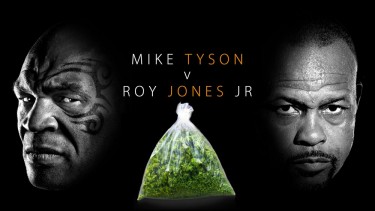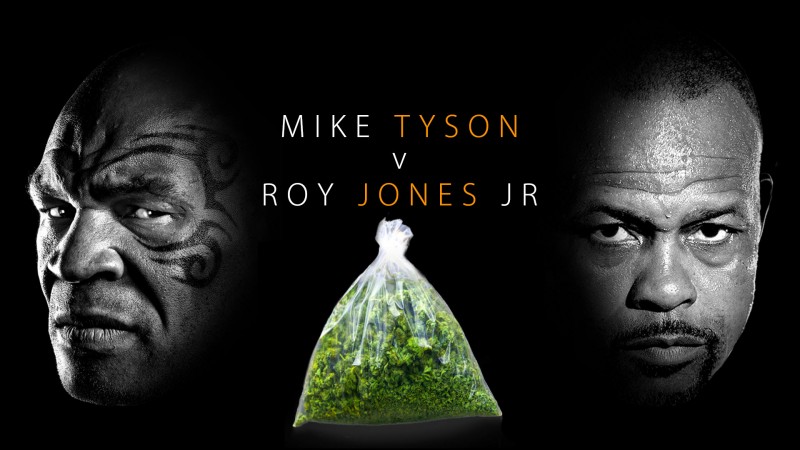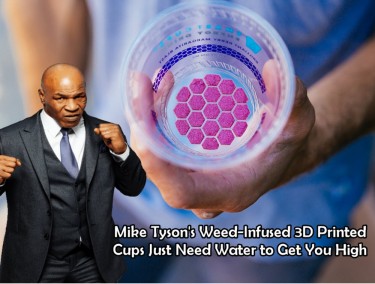The Biggest 2020 Weed Event Everybody is Talking About ft. Iron Mike

This year, 420 was canceled – or “celebrated remotely” which is essentially the same as “canceled”. Other than that, weed has actually had a pretty spectacular 2020. Not only are dispensaries thriving amidst the Covid Anxiety, but also many more states legalized medical and/or recreational cannabis.
However, one of the “non-weed-Weed Events” played out on November 28th 2020. If you’re not sure what I’m referring to, it was the Tyson vs Roy Jones Jr Fight.
While the event in itself wasn’t screaming cannabis, it certainly had hints of cannabis sprinkled ever so subtly. For example, Weedmaps was one of the sponsors and the logo of the company can clearly be seen in the Ring.
Snoop Dogg was one of the commentators and of course, Tyson is now a legend within the cannabis community with his own Tyson Farms and cannabis brand. While there was no overt marketing for cannabis – which would have been amazing – this was a major shift in public perception of cannabis.
Some might scoff at the idea that the fight was “gimmicky” and the fact that – SPOILER ALERT – it ended in a draw, millions of people saw it and millions more will stream it in the coming months. What happens then is that the subtlety of the marketing will seep deeper into the microcosm of the spectator and once more – inching weed’s inevitable immersion into society forward.
The Fight Made Marijuana Headline
Why am I writing about the fight? Simply because it achieved its intended effect. The fight was widely reported, Joe Rogan hyped it up and two days afterwards, the only headline worth mentioning was the “I smoked marijuana before the fight” as Tyson claimed he was stoned.
Of course, some may believe that this is “giving him an advantage”, but as Tyson mentioned…
“I smoked every day” during while training for the fight, Tyson said during the post-fight press conference. “I never stopped smoking.” - Source
This was one of the major headlines running in several publications. And they aren’t wrong. I mean, I’m writing about it right now and you’re reading it…so…marketing successful? You tell me.
Even though this isn’t a typical event by any stretch of the imagination in that, both of athletes involved are considered “legends” of their craft and as such, the match was officially sanctioned by the California State Athletic Commission.
This means at least in the eyes of the state of California, the match was an “official Athletic bout”, yet despite this there was no prior drug testing done.
And even if there were any testing done, Tyson and Jones were duking it out more over the idea of whether they still could do it in their 50s, and they proved to the world that they could.
However – while the match ended in a draw, you could clearly see that Tyson still had some energy in him and could keep on fighting, Jones on the other hand started lagging at the end of the bout. Perhaps a few more rounds with Tyson would have changed the outcome of the match.
Either way, it was pure genius watching these two titans battle it out in the ring. There were some classic moments that reminded us just how great these two were.
All of the clout of the fight certainly got millions of people tuning in and as a result – the winner of the match was Marijuana.
Cannabis and Athleticism
There is this notion that “athletes need to be sober” to showcase that they “have what it takes”. Yet I don’t particularly subscribe to this idea. If there are substances that allow you to heal faster, reduce inflammation, boost the immune system and help regulate other functions of the body – wouldn’t you encourage athletes to take it. At the very least, would you not simply ignore it if anyone did use it?
In the case of marijuana, it serves both as a recreational substance but also a medical one. These high impact sports often leave the athletes bruised and battered. In boxing particularly the risk of brain damage is high.
THC acts as a protector to the brain and while the CSAC believes that “cannabis slows you down making it more dangerous for the athlete”, science would suggest that it may also be the best thing to protect their brains when being punched by the likes of someone like Mike-BLEEPING-Tyson.
Which brings us to the current status of cannabis in the US – legal (but not) which creates a load of problems. I say, if an athlete can take pain killers to cope with pain after a match, they should also be allowed to use cannabis after a fight for healing. If you truly want to be a stickler for sobriety, then do what Nevada does and simply ensure that none of the participants smoked for at least 12-hours before participating.






